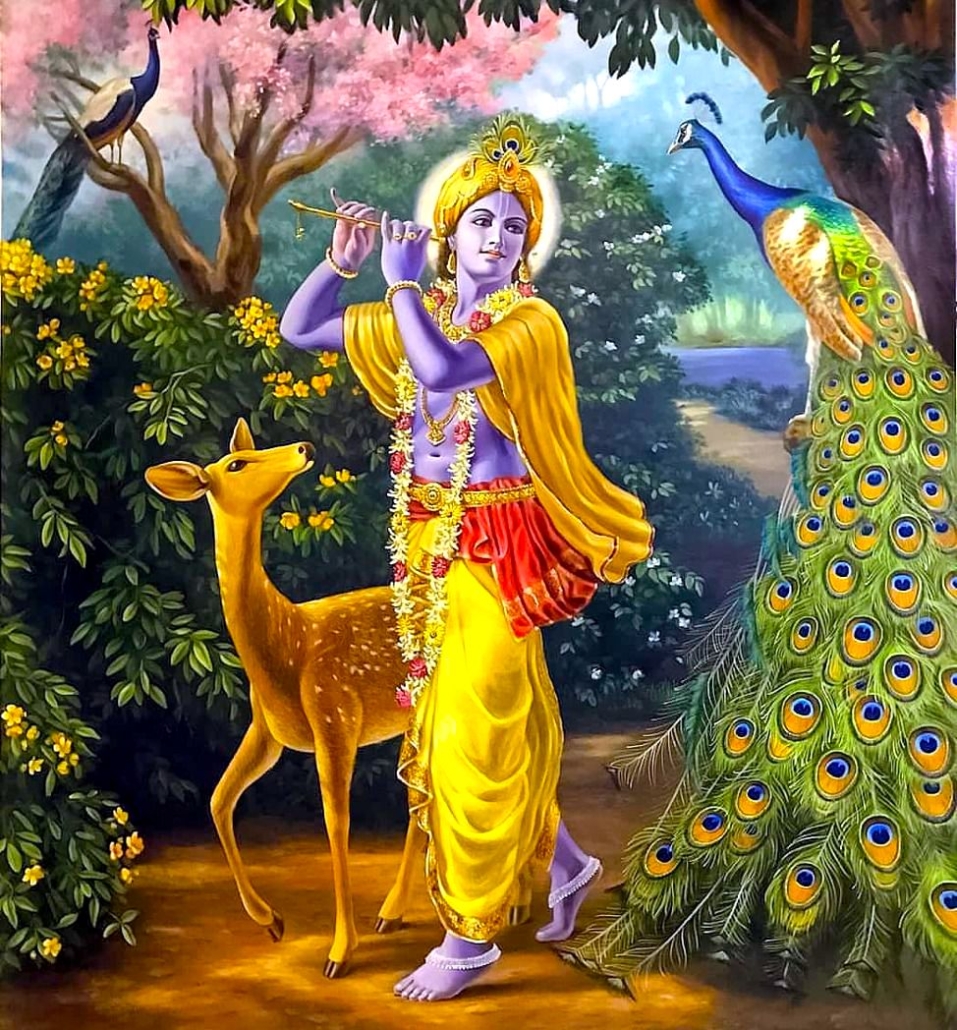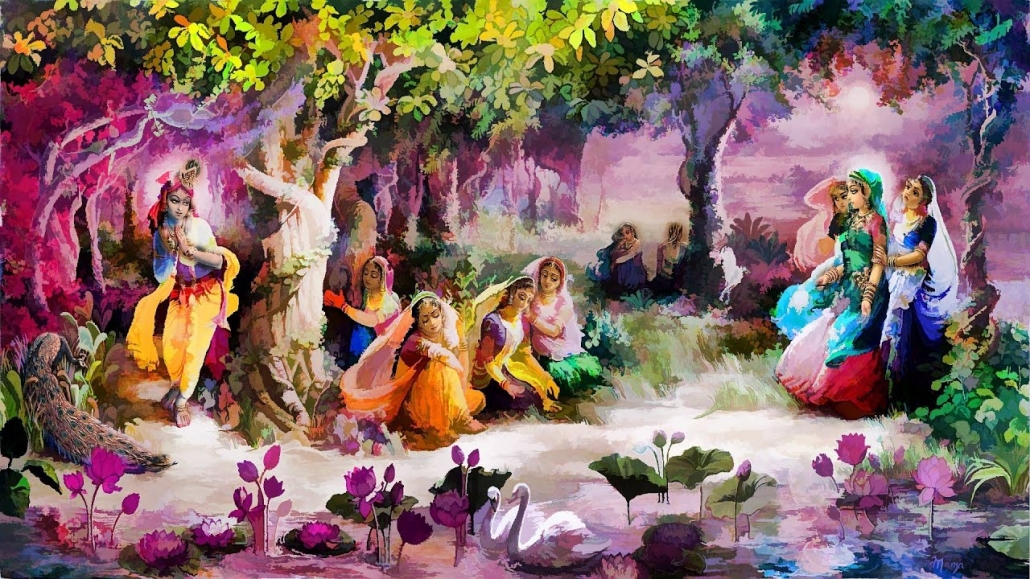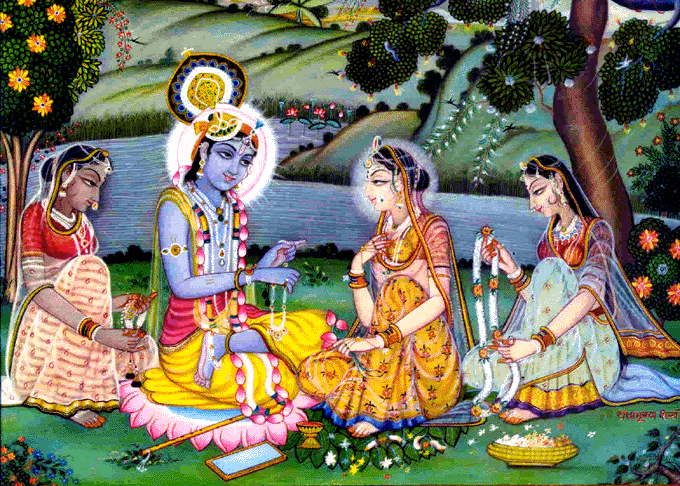Mahanidhi Madan Gopal Das
Srila Rupa Goswamipada says (Bhakti Rasamrita Sindhu (1.2.291) raganuga-bhakti sadhana can begin when one has a slight but specific hankering and desire (lobha, divine greed) to experience the feelings and render services like a particular eternal associate of Sri Krishna in Vrndavana i.e. Sri Radha, Visakha-sakhi or Sri Rupa Manjari in madhura-rati (vraja-vasi jana bhaava lubdho).
Regarding this, Srila Prabhupada says (Nectar of Devotion, pg. 125), “There is a gradual development to become like a particular devotee.”
In the next verse (Bhakti Rasamrita Sindhu 1.2.292), Srila Rupa Goswamipada says divine greed may appear and develop by repeatedly hearing [or reading] sastras like the Srimad Bhagavatam and books of the six Goswamis. Sri Jiva Goswamipada says that to develop raganuga-bhakti sadhana, one should especially hear the Tenth Canto Bhagavata’s depiction i.e. [Gopi-gitas) of the sweet love and activities of the cowherd damsels of Vrajabhumi.
In (Bhakti Rasamrita Sindhu 1.2.294), Srila Rupa Goswamipada says practicing raganuga-bhakti means to live in Vraja Mandala and be absorbed in hearing topics specifically related to the Vrajavasis whom you want to follow, such as Radhika and the Vraja-gopis.
For devotees pursuing Vraja bhakti in the amorous mood of the gopis, the Srimad Bhagavatam contains six priceless jewels known as the six Gitas or songs of the Vraja-gopis. Bhagavatam is the cream of the Vedas, and the Gopi-gitas are the burfee of the Bhagavatam.
Why is that you may ask? The six Gopi-gitas are full of deeply emotional, pure love-surcharged verses that have arisen from the Vraja gopis’ immaculately pure hearts. In these outpourings, often cried out in the agony of separation from Shyam, the Vraja-gopis reveal the topmost transcendental ecstatic sentiments of mahabhava, pure and selfless, divine love for their dearest Priyatama Shyama, Sri Krishna!
The Gopis’ songs are especially meant for sadhakas treading the emotional path of raganuga-bhakti in pursuance of the madhura-rati of Sri Krishna’s Vraja ragatmikas as taught by Sri Chaitanya Mahaprabhu. By regularly hearing, reading, or better yet crying like they did, these six songs of love divine, devotees will quickly develop the moods and feeling of the damsels of Vraja.
The Vraja gopis sing these six Gitas either in times of union or separation, while relishing the ecstasy of their srngara-prema, pure ecstatic amorous love for Shyamsundar, the beautiful dashing sweet Lord of Love.
Srila Sukadeva Goswami comments (Srimad Bhagavatam 10.33.36) on these Gitas, “People must hear about Krishna pastimes [in the six Gopi-gitas]. By doing so people will become exclusively devoted to Bhagavan Sri Krishna.”
Many contemporary Vrndavana Goswamis and Bhagavata katha vachaks say that if you want to cultivate the gopi’s mood separation, attract the heart of Krishna, and receive His beautiful darshana, then daily sing the “Gopi Gita”. (Srimad Bhagavatam 10.31.1-19)
Moreover, since the Vraja-gopis are the topmost devotees of Bhagavan Sri Krishna in all of creation, any devotee who daily hears, reads, or cries these songs will surely increase his/her attraction, love and attachment for Sri Krishna, our Sweet Loving Master.
OUTLINE OF THE SIX GOPI GITAS
- Venu-gita:
In verses (10.21.7-19), the gopis describe Sri Krishna’s purvahna-lila (8:24-10:48 a.m.) in the morning when Govinda goes out with gopa friends to tend the cows in the forest. While the gopis are staying at home they hear Krishna sweet flute song echoing and resounding in the distant pastures. Their hearts thrill with ecstatic hankering. Then to ease their pangs of separation, the lovely damsels of Vraja sing about their beloved Shyam, His amazing flute, and His frolicking in the forests of Vrndavana.
- Pranaya-gita:
This Gita appears in the Tenth Canto at the end of the first chapter describing the rasa-lila (SB 10.29.31-41). After the gopis hear Sri Krishna’s flute invitation for amorous sports, they drop everything and run through the frightening midnight forest to stand before their beloved. And what does Shyam do? He preaches patni dharma, lajja dharma, varna dharma and morality to seemingly dissuade and reject them.
Replying, the Vraja damsels forcefully express their pure intentions, and transcendental loving sentiments for the one and only true husband and master of everyone, Krishna! In their talks about the deepest pure love, the Vraja-gopis reveal a type of sweetness in prema called pranaya. To better understand the gopis’ feelings at this time, please attentively read and reflect upon the following passage:
Pranaya-prema is a spiritual mentality of equality and oneness of heart between the lover and beloved. It includes boldness, firm faith and trust, and it is completely free from the slightest scent of reverence. Ujjvala-nilamani states that alaukik pranaya is the fifth stage (rati, prema, sneha, mana, pranaya) of ever-thickening sweetness in divine love. In pranaya prema, the lover completely identifies with the beloved, but not like the oneness of the jiva identifying with Brahman in sayujya-mukti.
At this level the lovers feels that their life-airs, minds, intelligence, bodies, and garments (prana, mana, buddhi, deha, vesh) are identical with the counterparts in their beloved. The lovers think, “You are my very prana and I am your very prana (life force).”
Thus, in their loving exchanges there is no hesitation, fear or distance created by respect or feelings of difference. For example, Sri Krishna can place His feet on Radharani’s breasts or pass His chewed pan into Radha’s mouth without any fear or hesitation.
- Gopi-gita:
This Gita (10.31.1-19) comprises the entire third chapter of Radha-Krishna’s rasa-lila in the Tenth Canto of Bhagavatam. On the camphor white, soft sandy banks of Yamunaji, the gorgeous gopis sing the pranaya-gita directly to Sri Krishna in chapter 29. Then later in the night during the rasa lila, Sri Krishna suddenly disappears leaving the damsels distraught and dejected.
Overwhelmed with broken hearts and sobbing continuously, the gopis sit down on the bank of the Yamuna after searching a long time for Krishna. Each in her own way, the gopis ecstatically cry out to Rasikashekhar while praying for Shyam’s merciful darshana.
Their minds filling with Krishna’s pastimes and presence, and their hearts burning in loneliness they cry out for their beloved. The commentators say singing the “Gopi-gita” will assuage the aggrieved heart of any bhakta who truly feels separation from Krishna.
- Yugala-gita:
This Gita appears in (Srimad Bhagavatam 10.35.2-25). Although wanting, the gopis can’t run out with Shyam when He goes to the forest every day. But their minds do run out. So while remaining in the village doing their chores, the gopis sadly pass their time singing of Krishna’s pastimes while eagerly awaiting Shyam’s return.
Standing in small groups here and there in Vraja, the gopis recite pairs (yugala) of verses glorifying Sri Krishna’s late afternoon pastimes (aparahna-lila 3.36- 6 p.m) of returning from the pasturing grounds (uttara-gostha lila) with the cows and cowherd boys.
- Viraha-gita:
Viraha-gita is in (Srimad Bhagavatam 10.39.19-31). This chapter describes one dismal day in February, when Akrura comes to town to take the tender boys Krishna and Balarama out of Vraja and on to Mathura City for a wrestling match with the fierce and hefty henchmen of the notorious demon King Kamsa.
Priyaji Radha and the other gopis are afraid to be without Shyama for even an eye blink. So when they hear the news, they become extremely upset and distressed.
Their faces turn pale from their heavy breathing, and their dresses, bracelets and braids slip off. When Radhika hears the bad news, She remembers some intimate moments with Shyama and faints.
Tossing in the high waves of prema, the Vraja-gopis stay up all night vacillating between madness and fainting. Half-conscious, the gopis lament and condemn Providence for separating them from Shyam.
Due to the intense anxiety of thinking that they may never see Krishna, the gopis run to Nandagrama at dawn. They decide to cast away their shyness and try their best to keep Krishna in Vraja. Standing at the door of Nanda’s palace, they openly express their deep feelings of love of separation in what is called the “Viraha-gita”.
In Nectar of Devotion (ch 44), Srila Prabhupada cites Srila Rupa Goswamipada’s Padyavali: “Since the inauspicious day when Krishna left Vrindavana to go to Mathura, Srimati Radharani has been pressing Her head on one of Her hands and constantly shedding tears. Radha’s face is always wet now, and therefore there is no chance of Radha’s sleeping even for a moment. Radharani was always weeping for Krishna because of His separation and She could not sleep for a moment.”
And how did Krishna feel in Mathura after being separated from His beloved sweetheart Radhika? In the Prahlada-samhita, Uddhava says, “Sri Govinda, panic-stricken from the piercing arrows of Cupid, is always thinking of Radharani. He does not eat regularly nor sleep at night.”
- Bhramara-gita:
This Gita appears in (Srimad Bhagavatam 10.47.12-20). After Sri Krishna leaves the gopis and moves to Mathura, He sends Uddhava back to Vraja with a message to pacify the gopis who are completely distraught in Krishna’s separation.
When the young maidens of Vraja see lotus-eyed Uddhava, wearing Krishna’s prasadi dhoti, turban and ornaments, they are astonished thinking that perhaps he is Krishna. The gopis bring Uddhava to a secluded place to speak confidentially.
As they remember their pleasurable pastimes with Krishna, the gopis abandon all propriety and shyness and loudly cry. At that time, Sri Radha sees a bumblebee and mistakes it to be a messenger of Uddhava or someone very dear to him and Krishna. Completely bewildered by intense pangs of love in separation from Shyam (divyonmada mahabhava), Radha speaks to that bee like a madwoman.
Uddhava tries his best to console the deeply anguished Radharani and the damsels of Vraja, who just want to see Shyam again, but he fails! Instead of pacifying the anguished gopis, Uddhava himself becomes baffled and astonished at Sri Radha’s intensely mad love in separation from Krishna.
The Bhramara-gita concludes with Uddhava’s response which is simply his heartfelt prayers to the gopis expressing his gratitude, appreciation and aspiration. Although he is a most exalted Vedic scholar and a confidential friend of Krishna, Uddhava prays with folded hands that the gopis will bless him in some life with their foot dust if by chance he gets birth in Vraja as a lowly creeper. It seems this pastime occurred during the morning (purvahana-lila 8:36-10:48 a.m.)
We hope this article will inspire devotees to cultivate their individual budding attraction to follow the Vraja-gopis by regularly hearing and reading these wonderful Gopi-gitas of the Tenth Canto.
Srimad Bhagavatam Gopi-gitas ki jai! Jai Jai Sri Radhe!



